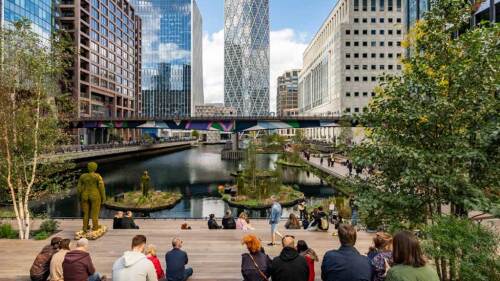While the grass may not always be “greener on the other side,” cities may be considerably greener on the other side of the Atlantic. That’s certainly the case with the Free and Hanseatic City of Hamburg, Germany, the 2011 European Green Capital. Hamburg officials visited ULI’sWashington, D.C., headquarters on November 30 for a transatlantic dialogue on urban sustainability initiatives. They were joined by planning officials from Boston, Baltimore, and Washington, D.C., as well as representatives from the embassy of the Federal Republic of Germany.
Hamburg is the second city to receive the coveted European Green Capital award from the European Commission; Stockholm was the first in 2010, with the award being passed to Victoria-Gasteiz in Spain next year. Hamburg was selected in part due to its ambitious climate protection goal of reducing greenhouse gas emissions by 40 percent by 2020 and by 80 percent by 2050. In contrast, the European Union as a whole is aiming for a 20 percent emissions reduction by 2020.
The German delegation began by describing Hamburg, Germany’s second-largest city, home to 1.8 million people within its city limits and 4.3 million in the metropolitan region. Hamburg’s canals and waterways are spanned by almost 2,500 bridges—more than Venice, London, and Amsterdam combined. Nearly 17 percent of the city’s land is green with forests, parks, and recreation areas; water covers another 8 percent of the city.
Hamburg’s environmental achievements and goals are even more significant in light of its status as a center of heavy industry, with 500-plus industrial enterprises including Europe’s largest copper smelting plant. Its River Elbe port, whose size is exceeded in Europe only by Antwerp and Rotterdam, handles more than 100 million metric tons (110.2 million tons) of goods every year while providing some 150,000 jobs.
So how does an industrial city become a European Green Capital? “Even while tackling fiscal challenges similar to those of U.S. cities, Hamburg has developed an impressive track record of integrating investments in both existing neighborhoods and the large-scale redevelopment of its waterfront,” said ULI senior vice president Uwe Brandes, who moderated the dialogue. “The fact that this integrated strategy has produced both globally significant urban design and publicly documented emission reductions provides great inspiration.”
As a major industrial center, Hamburg confronts all the environmental challenges that face other European cities, noted State Secretary Wolfgang Schmidt. Because it is both a city and a state, Hamburg has a unique ability to influence national laws, and also receives federal funding for performing state administrative functions. Hamburg passed a Municipal Climate Protection Act in 2007, and from that developed its sustainable energy action plan, funded to the tune of 20 million euros ($26.7 million USD)per year. Over 462 individual measures were implemented or planned in 2011.
One of Hamburg’s biggest success stories is a public/private partnership encouraging private business to invest in resource efficiency and reduce greenhouse gas emissions. The industrial industry, which generates about 30 percent of Hamburg’s carbon dioxide emissions, already has reduced emissions by 330,000 metric tons (363.8 tons) (in mid-2010), a figure expected to increase to 500,000 metric tons (551.1 tons) by 2012. Each euro invested by Hamburg’s government is matched by ten euros from the private sector.
Hamburg’s climate protection initiative also includes an extensive information dissemination program with over 500 events, conferences, symposiums, and dialogues to date, as well as an ambitious green harborside redevelopment and a variety of demonstration projects too numerous to mention. The city’s programs, combined with a nationwide commitment to environmental protection, have helped create some 370,000 green jobs throughout Germany. More than 600 businesses in and around Hamburg are involved in renewable energy—building solar plants, designing wind farms, working on new ways to use biomass, and more.
Hamburg’s climate protection initiatives also extend to the robust public transportation system in the city. Virtually all Hamburg residents have access to public transport within 91 feet (300 m) of their homes—a higher proportion than in any other European city. Hamburg also is home to the world’s largest fleet of hydrogen-fueled buses, and has 53,000 registered users of its bicycle program. Six ferry lines serve the harbor and the River Elbe, while a fleet of small lower-emission taxis is being launched this year.
And to make city living even more desirable—especially to young people—Hamburg plans to start offering free child care for up to five hours a day, along with subsidized college tuition and a continued emphasis on providing affordable housing to city residents.
So how can U.S. cities, given their current dire financial situations, emulate Hamburg’s success on any level? “European energy prices are much higher than those in the U.S., so we cannot motivate U.S. citizens to take this issue seriously,” noted Galen Nelson of the Boston Redevelopment Authority. “We need to tell the climate change story to change citizens’ attitudes.”
According to Harriet Tregoning, director of planning for Washington, D.C., U.S. cities must make the effort, despite the cost. “We look at Hamburg
and other European cities as competition, in a positive way,” she said. “We all need to attract smart, young people to live in our cities, using transit instead of cars. But to do that, we need to change our culture. Americans are not good at sacrifice, so we need to make it fun to get out of the car and walk, just like Detroit’s advertising aims to make driving fun.”
Many U.S. cities face enormous challenges and struggle to make environmental protection a priority. In Baltimore, for example, the population has been declining steadily since it peaked in 1950, and large areas of blight have impeded the city’s progress for decades. Nonetheless, said Thomas Stosur, Baltimore’s director of planning, the city plans to launch a climate action plan, has received a U.S. Department of Housing and Urban Development Sustainable Communities grant, and has adopted an aggressive urban agriculture plan as a potential solution for blighted neighborhoods.





